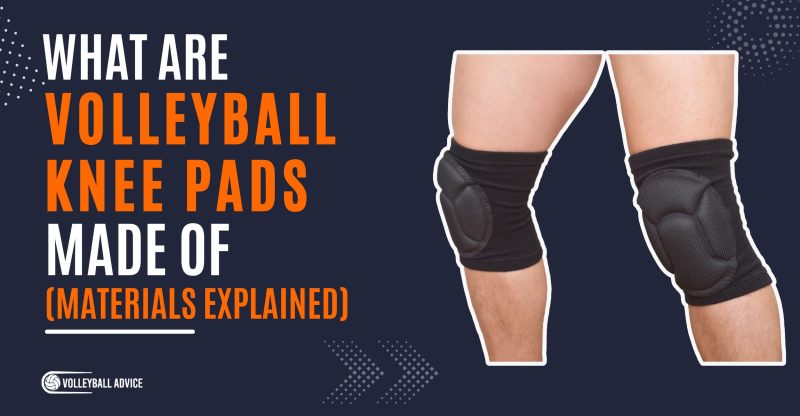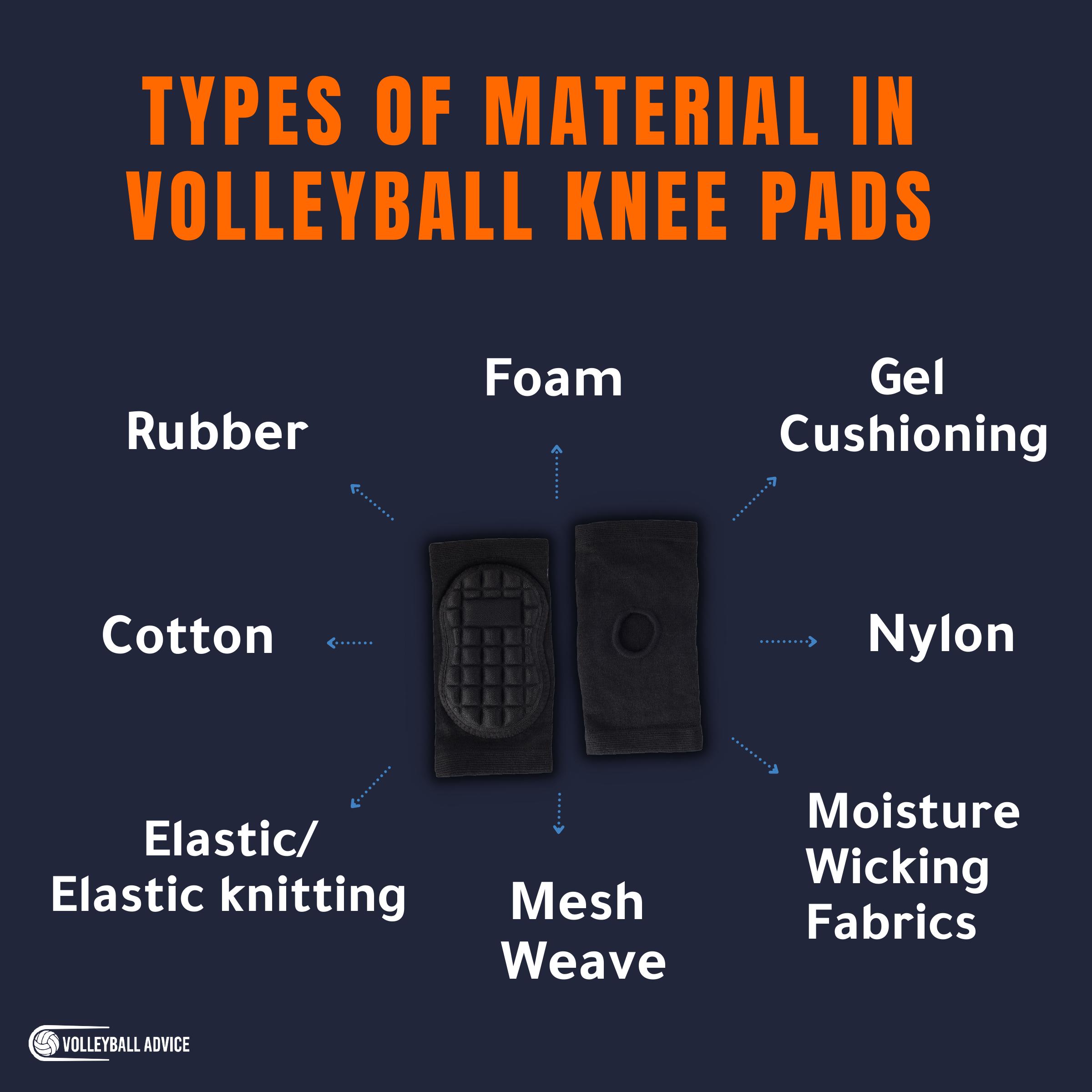What Are Volleyball Knee Pads Made Of? (Materials Explained)
Some links in this article are affiliate links, which means I earn from qualifying purchases. buy alprazolam for dogs uk https://attentiontrust.org/
Using the wrong material for your volleyball knee pads will make them less effective at their job and even shorten their lifespan. That becomes not only a waste of time, but also a massive waste of money.
Thankfully, the responsibility is on the brands that produce the equipment to research, wear, test, and produce the right material for us. However, that doesn’t mean we as players shouldn’t know what we’re getting ourselves into.
So, what are volleyball knee pads made of? Volleyball knee pads are made of cotton, rubber (or foam), and nylon, but can also incorporate gel cushioning, elastic knitting, mesh weaves, and various “moisture-wicking fabrics” of the company’s own design. The difference in cost can be mainly attributed to branding, design, and the quality of materials.
Money and performance aside, certain players can have reactions to some blends of materials, leaving rashes or irritated skin – especially on the backside of the knee. For these players, this article will be even more useful.
Below, I am going to be breaking down what volleyball knee pads are made of and how the aforementioned materials are used. Along the way, we’ll talk about design before finishing with three examples of knee pads currently in use.
Types of Material In Volleyball Knee Pads
The 8 types of materials used in volleyball knee pads are:
- Rubber
- Foam
- Gel Cushioning
- Cotton
- Nylon
- Elastic/Elastic knitting
- Mesh Weave
- Moisture Wicking Fabrics
1. Rubber/Polyurethane
Polyurethane is one of three cushioning solutions that knee pad developers have chosen to use.
A highly durable material with slightly less give than foam, it is used in the padding part of the knee pad and is used to protect the knee from impact.
Because Polyurethane has a high level of friction when in contact with the floor, layers of other fabric and material – such as cotton – are typically layered over the rubber elements, helping it last longer and work better.
2. Foam
Foam is the second cushioning solution, and is a deceptively fragile material with very little structural integrity.
Most iterations of foam can be torn apart just with the fingers, so it needs to be enclosed in material to give it strength and form.
Foam is the most gentle material for cushioning, and so is a staple of some brands of knee pad makers.
3. Gel Cushioning
The last cushioning solution, gel cushioning, is a liquid filling that decreases impact by spreading the force across the changeable surface.
This is usually found in more expensive or specialist knee pads, however.
4. Cotton
A staple of most clothing, cotton is lightweight and versatile.
It is used to enclose the padding and make the elastic more gentle to the skin.
5. Nylon
The synthetic partner to cotton, nylon, is incredibly useful and prolific in sports clothing.
Used in kneepads to blend with cotton to make moisture wicking fabric, and occasionally on its own.
6. Elastic/Elastic Knitting
Sometimes called “nylon elastic”, this material is similar to nylon but provides more elasticity, giving the knee pads the grip needed to remain in place.
It’s used in the sleeve of the pad.
7. Mesh Fabric
This material is incredibly breathable, and is typically used to provide airflow to the back of the knee and alleviate sweating.
Mesh fabric is also used in the sleeve.
8. Moisture Wicking Fabrics
Not truly a material by their own, “moisture wicking fabrics” are blends that are changed by companies to their own specifications in attempts to repel sweat and other moisture, keeping the pads looking and working well longer.
Typically blends of nylon, cotton, and lesser materials, and is used primarily in the sleeve.
Design of Volleyball Knee Pads
There are pretty much only four methods of design for volleyball knee pads, and they range from the cheapest and simplest solution (single pad) to the most scientific and sports-technical possible (modular).
All perform the same function, more or less, however; this guide is intended only to help you identify the different types out there.
Single Pad Cushioning
Single pad cushioning involves a single compartment of cushioning material to cover the entire knee.
Examples of single pad cushioning are Body Prox and Nike.
Split/Foam Padding
Split/foam padding splits the cushioning into multiple compartments that sit in bands across the knee, increasing the knee pads’ durability, effectiveness, and area protected.
An example of split/foam padding is Asics.
Compression Sleeving
Support sleeving exists to provide the knee (and other joints) with as much support and safety as possible, preventing injuries before they occur. If this is something that interests you, check out compression clothing.
An example of compression sleeving is McDavid.
Modular Cushioning
Modular cushioning is formed from scientific and athletic studies of the knee, resulting in intentionally crafted units of cushioning that conform to the shape of your knee. This results in less material used, meaning that it’s less bulky to wear, while providing more meaningful protection than other types of knee pads. Justifiably, this type is noticeably more expensive.
Examples of modular cushioning are Mikasa and Mizuno.
3 Knee Pad Examples & Their Materials
To finish, we’re going to break down three different brands of knee sleeves and their materials.
As I am neither a qualified designer of sportswear nor a biomechanical engineer, I won’t be focusing on whether the choice of material is good or not – only what they are made of and why. This will be of much greater practical use to the reader anyway.
These products have been designed by teams of people with clear qualifications to excel, so I shall leave the details to them. Let’s take a look.
Looking for a pair of knee pads? I’ve reviewed and tested dozens. You can find all my top recommendations in my article on the Best Volleyball Knee Pads.
Ventus Volleyball Knee Pads (Mizuno)
The Ventus Volleyball knee pads are a typical example of Mizuno’s research, featuring durable mesh at the back of the knee for ventilation, curved upper and lower hem to minimize excess fabric, and padding designed in the modular cushioning pattern for maximum support.
The main materials used are cotton, nylon, and rubber, though the product bio does not outline the amounts of each used. The mesh at the back is both durable and breathable, and like the rest of the materials used, is of excellent quality.
The interesting thing about this knee pad is that though the modular cushioning is a staple of Mizuno’s designs, the actual execution of it changes from product to product. This is intentional, as there are many different knees, and many different needs.
830/832 Knee Pads (Mikasa)
The 830/832 knee pads from Mikasa refer to two different lengths of the same knee pad, differing in the sleeve.
These knee pads are made of a circular elastic knitting that makes up the sleeve of the product, and ensures a lasting grip and conformance to your knee. Additionally, “moisture wicking” material is woven into the sleeve for antimicrobial and odor fighting purposes, ensuring that the material will last longer.
Nylon weave covers the padding, and the design is clearly modular cushioning, providing increased patella protection for the athlete.
This is a good example of a synthetic, woven knee pad that utilizes good integrity and sleeve strength to its advantage.
Asics ACE Low Profile Knee Pads
The Asics ACE Low Profile knee pads are great low profile knee pads with short sleeves, making them more breathable and suitable for any type of player.
According to their material information and product bio, they are composed of 43% cotton, 33% rubber, and 24% nylon. The cotton forms the outer material holding the pads and the sleeve, while the rubber forms the “dual-density” cushioning. Lastly, the nylon forms the elastic elements of the sleeve; it’s the stuff that helps your knee pads actually conform to your knee and stay on your leg.
This is a great example of a well balanced knee pad with decent materials and design, with a clearly laid out composition for athletes to consider. With rubber padding, it’s sure to last longer than foam compartments, and should serve you well in the long run.
Other Volleyball Knee Pad Resources
- How to Wash Volleyball Knee Pads Without Wrecking Them
- How Long Do Volleyball Knee Pads Last? (Honest Perspective)
- Volleyball Knee Pad Sizing (Do They Stretch?)
- How Much Do Volleyball Knee Pads Cost? (Breakdown Per Brand)
- Volleyball vs Basketball Knee Pads: Differences, Pros, Cons
- Best Volleyball Knee Pads For Liberos
About The Author
Ailan Samuel is a writer and athlete who has played volleyball at the university, club, and national level since 2012. He has competed successfully in both beach and indoor competitions, resulting in four silver and two gold medals, and was awarded the Half-Blue while playing in Scotland. He received his MA in English and Medieval History from the University of St Andrews, Scotland, and is currently studying for his MA in Publishing and Creative Writing at Bournemouth University.


